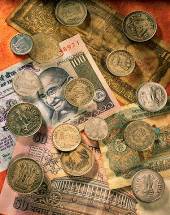 The finance minister is pushing public-sector companies into using their cash pile to kick-start a fresh capex cycle, or lose the cash.
The finance minister is pushing public-sector companies into using their cash pile to kick-start a fresh capex cycle, or lose the cash.
The move is being welcomed by capital goods makers.
Thermax Managing Director & CEO M S Unnikrishnan says: “Though it alone cannot revive capex cycle, PSUs can surely revive the capex cycle in sectors such as oil & gas, steel and fertilisers.”
However, an analysis of PSUs’ balance sheets suggests their operations are no more spewing tonnes of cash, nor are they hoarding cash.
Most PSUs have seen their cash reserves declining and financial ratios deteriorate in recent years -- due to a mix of poor profitability and rise in capital expenditure.
For others, cash on the books is an optical illusion, as they have resorted to borrowings in recent years to fund the gap between internal accruals and capex requirements.
The cash and equivalents as percentage of assets of the top-50 listed government-owned companies declined to 14 per cent during the first half of the current financial year, from a high of 26 per cent in 2009-10.
This ratio is much higher than the corresponding ratios for capital-intensive and high-performing private-sector companies like Grasim, ACC, Bajaj Auto, Maruti Suzuki, UltraTech Cement and Hindustan Zinc.
Not surprisingly, many experts are advising caution.
“The cash management is a commercial decision best left to the firms’ managements.
“Forcing companies to invest could lead to adverse selection of projects, impacting future income flows and putting them in jeopardy,” says CARE Ratings MD & CEO D R Dogra.
At the end of September last year, the country’s top-51 non-financial PSUs were sitting on cash and equivalents of around Rs 1,95,000 crore (Rs 1,950 billion), up 5.8 per cent over two-and-a-half
But the growth was entirely due to Coal India, which has seen a steady build-up in cash pile over the past five years and now accounts for a third of the aggregate cash reserves of all PSUs.
Its cash reserves have nearly tripled since 2007-08 and its share in PSUs’ aggregate cash reserves during the period doubled.
The coal miner, together with NMDC and ONGC, accounts for a whopping 55 per cent of PSUs’ cash pile.
Excluding these big three, government-owned companies have, on an average, reported a 21 per cent decline in cash on their books from the 2009-10 peak.
Steel Authority of India Ltd’s cash reserves have declined nearly 70 per cent from its 2009-10 peak, due to a decline in profitability and a sharp rise in capex.
The company is currently implementing Rs 27,300-crore (Rs 273-billion) capex, being funded through a mix of borrowings and internal accruals.
BHEL’s cash pile has halved in last three years due to a mix of capex and demand slowdown in the capital goods sector.
The finances of oil marketing companies were hit by fuel subsidies, leaving them with little surplus. Indian Oil Corporation, the country’s largest refiner, is now the most indebted PSU, with borrowings of nearly Rs 80,000 crore (Rs 800 billion), mostly on account of the subsidy burden.
It’s the same with its smaller peer Hindustan Petroleum Corp.
The result has been a sharp rise in borrowings, and the leverage ratio is now nearing the danger mark.
The net debt to equity ratio of PSUs shot up to one at the end of September, from 0.1 in 2009-10.
A further fall cash position or deterioration in business environment could push the finances of many PSUs in the danger zone.






